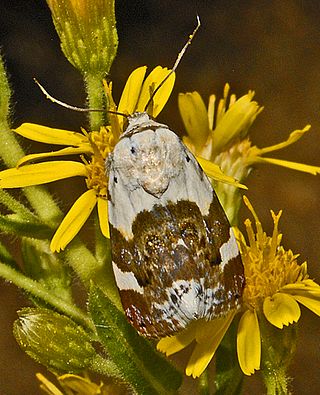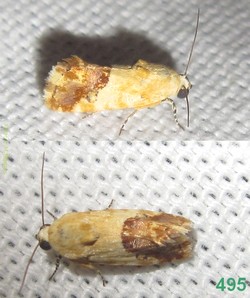
The woodbush legless skink is a species of legless skink. It is found in the Wolkberg mountains of Limpopo Province, South Africa. Females of the species give birth to live young. This lizard species was formerly placed in a monotypic genus as Acontophiops lineatus. Morphologically the genus shows similarities to Acontias cregoi and a recent review placed both of these within the genus Acontias, which, as Acontias lineatus was already occupied, required a new name for this species.

Emmelia trabealis, the spotted sulphur, is a moth of the family Noctuidae. The species was first described by Giovanni Antonio Scopoli his 1763 Entomologia Carniolica.

Acontia is a genus of moths of the family Noctuidae. The genus was named by Ferdinand Ochsenheimer in 1816. Eusceptis, Pseudalypia and Spragueia are sometimes included in the present genus, but here they are tentatively treated as different pending further research. Many species of Tarache were also once placed here.
Acontia gratiosa is a moth of the family Noctuidae first described by Hans Daniel Johan Wallengren in 1856.

Acontia lucida, the pale shoulder, is a moth of the family Noctuidae. The species was first described by Johann Siegfried Hufnagel in 1766.

Acontias gracilicauda, the slendertail lance skink or thin-tailed legless skink, is a species of skink. It is found in the Republic of South Africa and Lesotho. Acontias namaquensis was formerly included in this species as a subspecies, but is now recognized as a distinct species.

Acontia clerana is a moth of the family Noctuidae. It is found in Western Australia, New South Wales and Queensland.

Acontia nitidula, the Brixton beauty, is a moth of the family Noctuidae. The species was first described by Johan Christian Fabricius in 1787. It is found in South Africa, Europe, China, Japan and throughout India and Sri Lanka. It has also been recorded from Great Britain, but this record is doubtful.
A. bidentata may refer to:

Acontia transfigurata is a moth of the family Noctuidae. It is found in most countries of subtropical Africa south of the Sahara.

Acontia imitatrix is a moth of the family Noctuidae. It is found in most countries in Africa, from Morocco to Nigeria, Ghana to South Africa, Angola to Somalia, Yemen and Saudi Arabia.
Teragra guttifera is a moth in the family Cossidae. It is found in South Africa.

Acontia opalinoides is a moth of the family Noctuidae first described by Achille Guenée in 1852.










